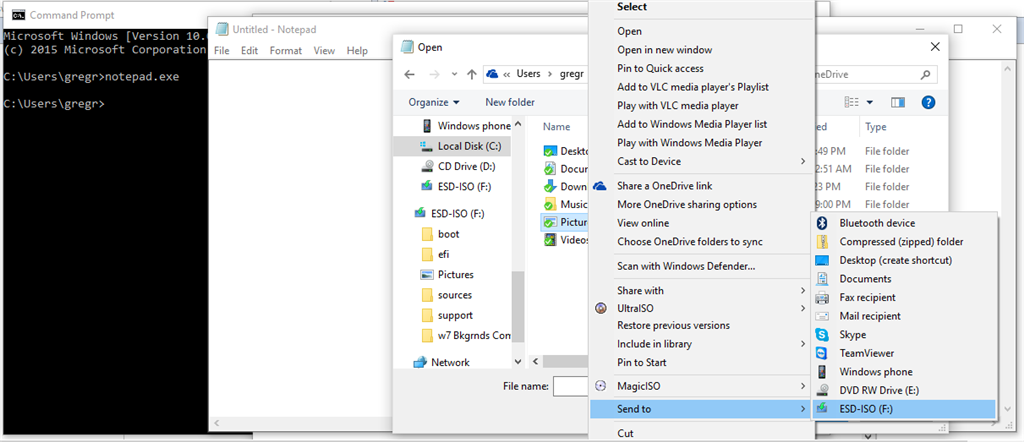Technical Level : Basic
Summary
Here's how to rescue your files to external USB when WIndows won't start. You can use the Command Prompt in Repair Mode or use bootable Windows installation media, Recovery Drive, or Repair CD.
Details
Files should always be backed up externally since the hard drive can die at any time and they will be unrecoverable. In addition back valuable files up to the Cloud in case of fire and to have the latest revisions.
To rescue your files to external USB when Windows cannot start, you can use whichever method works here to access the Command Prompt from Boot, if necessary by booting your bootable Windows installation media, Repair CD or Recovery Drive.
If needed now: Create Windows 10 Installation Media or Create Windows 11 Installation Media
Insert the bootable Windows installation media or Recovery drive.
Power up the PC, immediately and vigorously tap the BIOS Boot Menu Key to select the media to boot (as a UEFI device if offered) from menu like this:
If it bypasses the Boot Menu then use the key from chart in same link to enter UEFI firmware or BIOS setup to turn off Fast Boot, and from within Windows you can also change Settings > System > Power & Sleep > Additional Power Settings > Choose what Power buttons do > Change settings that are unavailable > uncheck Fast Startup. See also Four Methods to Access UEFI BIOS Setup in Windows 8/10 PC/Laptop/Tablet
At first screen press Shift + F10 to open a Command Prompt,
If this fails go to the next screen, choose Repair Your Computer,
then Troubleshoot,
Then Advanced Options:
Then Command Prompt.
In Command Prompt type notepad.exe
In Notepad, click File, then Open. This will open a Mini-Explorer that you can use to locate folders or individual files needing rescue, right click to Send to USB drive or DVD. During copying there will be no progress bar and PC will appear to be frozen. You only need to wait it out as it will unfreeze as soon as the copying is finished. This can take many hours for large files so you may want to copy them in smaller bites. I would wait overnight before giving up if it appears Frozen or no progress.
For example from booted Windows 10 flash installer, I chose my Pictures folder which is 4.7 gb, Sent it to the same flash stick that was booting the PC. On a Core i5 Lenovo Laptop with 8 gb RAM, it took 10 minutes to copy the entire folder after which I could continue as needed.
Before moving on to reinstall Windows, after you're sure copying has finished, Close the command Box, remove rescue media, put it in another PC to check that everything is there - especially that no folder was only partially copied.
Alternate Methods:
If the mini-explorer in Notepad throws memory errors or doesn't work, try one of these methods to copy files from the Command Prompt, starting with XCopy: How do you copy files from one drive to another drive?
Alternative bootable rescue tools include Paragon Rescue Kit Free Edition
or a Linux disk such as Peppermint3 - Create Live CD DVD USB To Use For Emergency Backup.
To get to Hidden Files requires a Linux disk, or using CMD to unhide files then copy from CMD.
If you have any doubts that you have everything you need, then be sure to read https://answers.microsoft.com/en-us/windows/forum/windows_11-wintop_backup/easy-free-backup-strategies-for-files-and-windows/0a900895-a4f1-4808-83dd-128e7b79d454 which provides a complete checklist of everything that must be remembered to back up before reinstalling.
To unhide and copy hidden folders see here: How to Hide or Unhide Files and Folders with Command Prompt
3 Ways to Copy Files in Windows Command Prompt - wikiHow
You can also remove and slave the hard drive in another PC, or use a SATA to USB adapter.
There is also a last-resort method to rescue files while installing although it results in less than a fully clean install because you cannot delete or even format partitions, only select C and click Next. This tells the installer to archive your User folders along with the entire previous install in a C:windows.old folder where you can find them to copy out after install, then delete that huge folder using Disk Cleanup for System Files: Disk cleanup in Windows 10 - Windows Help -


